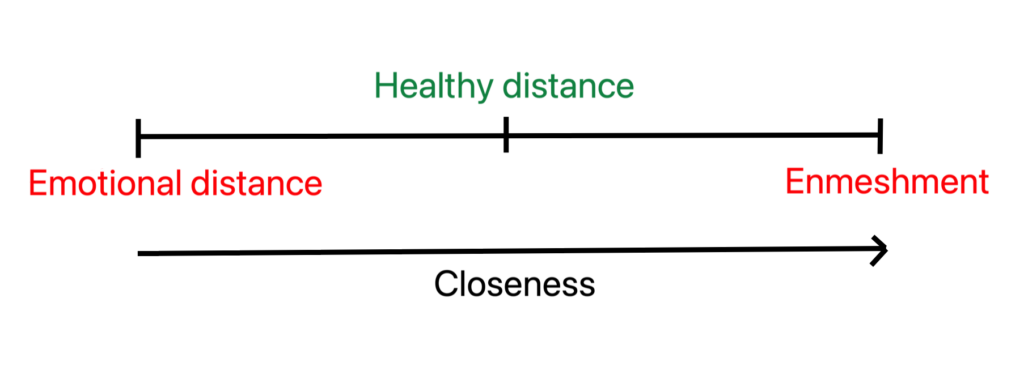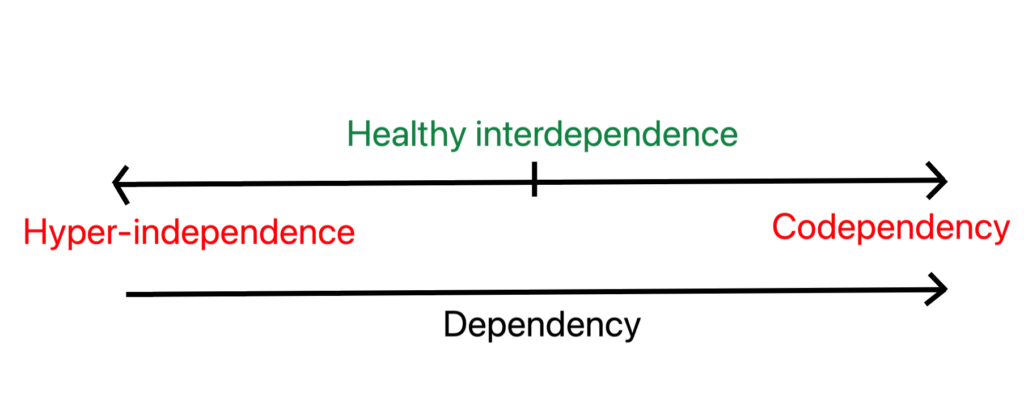The terms ‘enmeshment’ and ‘codependency’ are often used together and sometimes interchangeably. That’s because the two concepts are closely related.
Even though enmeshment and codependency are overlapping concepts, they have subtle but important differences.

Enmeshment
Enmeshment occurs when two or more people in a relationship setting, like a family, have a single, unified identity, which is also the family’s identity. Enmeshed family members all seem the same. They have the same thoughts, beliefs, and behaviors.
It’s like they’re all one person.
While enmeshment can occur in any relationship, it’s common in a parent-child relationship. Children who are enmeshed with their parents cannot separate and become their own persons.
Becoming your own person is an essential milestone in one’s psychological development. When that doesn’t happen because of enmeshment, a person fails to develop their self-identity.
Failing to form one’s own identity means not knowing who one is and what one wants. People who haven’t developed a strong sense of self tend to struggle in their careers and relationships.
They have no concept of boundaries.
In enmeshed families, the boundaries between family members become blurred or non-existent. You can’t tell where one person ends and the other begins.
Enmeshed family members are overly involved in each other’s lives. The family members are emotionally intertwined. They feel responsible for each other’s emotions and are overly affected by their emotional rollercoasters. The entire family unit feels the same way when one member feels a certain way.
Note that this differs from healthy emotional attunement, where you can feel the other person’s feelings without losing your sense of self.
Since enmeshed family members all identify with each other, they rely on each other to derive their self-worth. For instance, a parent who can’t separate themselves from their child may derive all their self-worth from the child’s accomplishments.
Enmeshed families make decisions together. Even small, insignificant ones. People who don’t come from enmeshed backgrounds, when they see that, they’re like:
“You could’ve made that decision on your own.”

Codependency
Codependency occurs when one or both partners in a relationship are overly dependent on each other to meet their needs, especially emotional needs. While codependency can happen in any relationship, it’s commonly discussed in the context of a romantic relationship.
A healthy relationship is one in which you meet some of your needs on your own and let your partner meet other needs. In a codependent relationship, you want your partner to meet almost all your needs.
Codependent people put their partners’ needs first and foremost. The natural consequence is letting your needs fall by the wayside. When that happens, you lose your identity.
So, while enmeshment is about being unable to form an identity, codependency is about losing one’s identity in a relationship.
When one or both partners lose themselves in a relationship, boundaries disappear. Codependent partners cannot be assertive and cannot reinforce their boundaries.
Unlike enmeshment, codependency stems from a fear of abandonment. A codependent person is so afraid of being abandoned that they invest their entire identity into the relationship.
They have no other source of self-worth except the relationship.
Enmeshment and codependency often co-occur. While the two can occur independently, enmeshment can lead to codependency and vice versa.

Enmeshment vs codependency
Here’s a summary of key differences:
| Point of difference | Enmeshment | Codependency |
| Context | Family unit | Romantic relationship |
| People | 2 or more people | 2 people |
| Sides | Both-sided, all-sided | One-sided or both-sided |
| Self-identity | Failing to form self-identity | Losing self-identity |
| Identity adoption | Adopting family’s identity | Adopting partner’s identity |
| Emotions | Responsible for others’ emotions | Meeting partner’s emotional needs |
| Roots | Overprotective or controlling parents | Low self-esteem, fear of abandonment |
